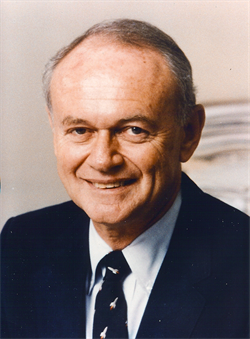Jerry Grey, Aerospace America’s Founding Publisher, Dies at 93 Written 10 February 2020
CONTACT: Michele McDonald
703.264.7542
michelem@aiaa.org

February 10, 2020 – Reston, Va. – The American Institute of Aeronautics and Astronautics (AIAA) mourns the passing of Jerry Grey, an AIAA Honorary Fellow and founding publisher of Aerospace America, the Institute’s flagship publication.
Grey died on 4 February 2020 from complications of pneumonia at age 93.
“Jerry was a passionate AIAA member who has had lasting influence on the Institute, in particular Aerospace America,” said Ben Iannotta, Aerospace America editor-in-chief. “He set the tone and look for the magazine when it debuted in 1984. He always let us know when an issue of the magazine was particularly on the mark. I am grateful for Jerry’s guidance and that he trusted us with his ‘baby.’ He was an aerospace pioneer who led by the quality of his work and whose passing is sorely felt.”
Professional accomplishments listed in Grey’s obituary include:
He held Bachelor’s and Master’s degrees from Cornell University and a Ph.D. from the California Institute of Technology. He was a professor of aerospace engineering at Princeton University for 55 years, where his research in rocket combustion instability was instrumental in assuring the reliability of the Redstone rocket that launched Alan Shepard, America’s first astronaut, and of the Saturn launcher’s giant F-1 rocket that placed the Apollo astronauts on the moon.
As Director of Princeton’s Nuclear Propulsion Research Laboratory, Grey was a pioneer in the field of space nuclear propulsion and power. At Princeton, he created and taught the first university course on space nuclear powerplants. With the eminent scientist Arthur R. Kantrowitz, he was co-inventor of the Kantrowitz-Grey molecular beam source, which is the standard tool for research in this field.
He holds a dozen patents in high-temperature instrumentation, a field in which he was preeminent for years. Grey published over 400 technical and popular books and peer-reviewed papers covering broad areas of aerospace and energy science and technology, and consulted actively for a number of aerospace organizations and government agencies, including the U.S. Air Force (as a participant in several “Beyond the Horizons” studies); NASA (as a member of the NASA Advisory Council); the U.S. Department of Energy (as a member of the Secretary of Energy Advisory Board); the Department of Transportation (as vice-chairman of the Commercial Space Transportation Advisory Committee); the U.S. Congress’s Office of Technology Assessment (as Chairman of a number of Advisory Panels on space, aeronautics, and energy); the National Reconnaissance Office (as Chairman and organizer of eight conferences on Space Launch Integration); Lockheed Martin Astronautics and its predecessor companies General Dynamics Space Systems (GDSS), and Martin Marietta (as a member of the President’s Advisory Council); the Applied Solar Energy Corporation (as Director); the Universities Space Research Association (as a member of several Science Advisory Councils); and NASA’s and the Atomic Energy Commission’s joint Space Nuclear Propulsion Office.
Grey was elected a Fellow of Great Britain’s Royal Aeronautical Society. He served as Vice President of AIAA and of the International Academy of Astronautics, and was President of the International Astronautical Federation. He was Deputy Secretary-General of the Second United Nations Conference on the Exploration and Peaceful Uses of Outer Space (UNISPACE 82) and for twenty years wrote the annual report, “Highlights in Space Technology and Applications” for the UN’s Committee on the Peaceful Uses of Outer Space.
Grey was Chairman of the American Association of Engineering Societies’ Coordinating Committee on Energy; a charter member of the Science Advisory Board of the NASA Institute for Advanced Concepts; and Chairman of the organizing committee that created the Center for Space Nuclear Research at the Idaho National Laboratory, which is operated by his client, the Universities Space Research Association. As the founder of the AIAA’s Public Policy program, Grey testified frequently at congressional hearings and represented the aerospace profession to the public media: television, radio, newspapers, and magazines, where he was quoted frequently on aerospace issues of national interest.
About AIAA
The American Institute of Aeronautics and Astronautics (AIAA) is the world’s largest aerospace technical society. With nearly 30,000 individual members from 85 countries, and 95 corporate members, AIAA brings together industry, academia, and government to advance engineering and science in aviation, space, and defense. For more information, visit www.aiaa.org, or follow us on Twitter @AIAA.
###
American Institute of Aeronautics and Astronautics
12700 Sunrise Valley Drive, Suite 200, Reston, VA 20191-5807
Phone: 703.264.7558 Fax: 703.264.7551 www.aiaa.org
